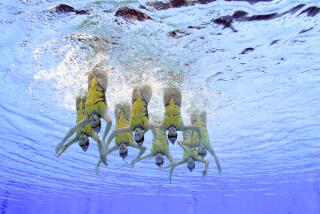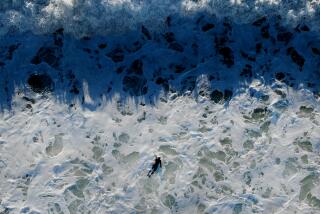Women starting to make waves in skimboarding
- Share via
Sprinting toward the surf, Shonna Cobb flings a fiberglass board onto the wet sand. With a springy assurance, she leaps atop the narrow 4-foot-long board and glides into an approaching wave.
In the seconds that follow, she will have to calculate the wave’s advance and the body movements required to sustain enough speed and balance to skim over its 4-foot face and into the air.
There is no soft landing. She completes the acrobatic trick, then falls into the receding shallow water at Balboa Beach, absorbing the impact with a tuck-and-roll motion.
“There’s a reason why there aren’t many women skimboarders,” she says with a laugh. “It hurts!”
Cobb, 26, of Long Beach, is a full-time veterinary dental assistant and former dancer. She also is among the most accomplished amateur female skimboarders in the world -- and has the scrapes and scars on her shins and feet to prove it.
This year, Cobb and at least half a dozen other women skimmers go pro.
The rough-and-tumble sport was born in Laguna Beach more than half a century ago. Yet skimboarding is still considered the poor cousin of surfing, which provides longer rides on enormous swells. Skimming also commands a far smaller market.
“There’s a ton of women surfers in the world today, but not many women -- or men -- who skimboard,” said Butch McIntosh, editor and publisher of 10-year-old Skim magazine. “I believe that is because it is a brutal, demanding sport that beats you down into the sand.”
Typically, the board hydroplanes across shallow water and, seconds later, smacks into a wave at just the right angle to glide across its surface. The goal is to turn around and surf back to shore.
Some maneuvers catapult the rider more than 12 feet into the air. The thrills last for 10 to 15 seconds.
Cobb, who has been skimming since she was 11, calls it “my meditation.”
“The moment I start running toward a wave, I feel totally alive and in a zone of meditation and endorphin releases,” she said, preparing to race toward an incoming swell on a recent weekday morning. “But if you hit the wave at a wrong angle, it’s tragic. You’re toast. I’ve cracked my head open a few times.”
Over the last 14 years, Cobb has won all but one of the nine amateur events she entered. “In that case, I had stepped on a rock and punctured my foot,” she recalled. “So I ran into a nearby animal hospital and had them stop the bleeding and close the wound with glue. Then I went back and took second place.”
Cobb is the top contender heading into the inaugural Victoria Skimboards Professional World Championship of female skimboarding, to be held June 19-20 in Laguna Beach. She leads a field of half a dozen or so contestants.
Lexi Hutchings, 23, of Utah and Lanakila Kelliher, 32, of Hawaii will be formidable, as will Jennifer Jacobs, 24, a political science major at Cal State Long Beach. Then there is Anna Prophet, 19, who said she moved to Dana Point from Panama City, Fla., in January so that she could prepare for the event by practicing “in Southern California waves, which are more powerful than anything we have back home.”
“If the waves are big and scary, I can take them,” Cobb said. “I’m not afraid to fall.”
Winning the first professional women’s world championship requires strong legs, abs of steel and a healthy dose of fear management. It will also call for putting up with the mocking from some male skimboarders who refuse to take their female counterparts seriously.
Men have dominated skimboarding championships for nearly a quarter-century.
Thousands of fans turn out to watch more than 100 men at a time vie for prizes that can reach more than $1,000, after competing all season in skimboarding tours subsidized by board makers. Winners get splashed across the pages of publications such as Skim magazine, which has yet to publish an article about female skimmers.
McIntosh said he is planning to run his magazine’s first piece on female skimboarders in November. “It will certainly include Shonna Cobb, because without her there wouldn’t be much to write about,” he said. “She is among the few women with the [fortitude] and talent to put up with it.”
It remains to be seen whether there will be a significant cash prize for the winner of the first professional women’s championship. The size of the purse is determined by the number of people expected to show up, and women’s events usually draw only the contestants’ friends and relatives.
A furor erupted when Victoria Skimboards executive director Tex Haines, sponsor of the upcoming championship, announced that the pro contests in June will begin with a coin toss, which will determine whether the women or men get first crack at the best high-tide waves of the day.
“It’s only fair,” Haines said.
Critics responded with complaints posted anonymously in the Skim Online chat room sponsored by the San Clemente company Exile Skimboards.
“This sounds like a load of bull,” one of them carped. “Do I go down to the local knittery and demand the best machine to make socks and mittens? No! Do I ask to use the oven at 6 a.m. on Thanksgiving? No! Why not? Because I know that knitting is women’s work and they should be allowed to knit using the best machines, and have the oven during the time when it is best to start cooking the turkey! As the better skimmers, we must get the best conditions and time to ride!”
Another wrote: “The women compete naked, right?”
In retrospect, said Exile owner and webmaster Aaron Peluso, “I should have deleted the comments that were over the top and left the ones that were merely intellectually offensive.”
Cobb recently ended her association with Exile, which had been her sponsor. She now rides for Melbourne, Fla.-based Slotstik Skimboards, which worked closely with her to create the first board designed for and by a female skimmer. Built out of carbon fiber, high-strength fiberglass and a foam core, it is adorned with Cobb’s autograph.
Overall, things are finally looking up for female skimmers. A year ago, the documentary “Skim Chicks” was released, featuring Cobb and other young women attacking waves at Southern California beaches. Pamela Simpson and Richard Tibbetts, who produced the film, also established the first nonprofit organization dedicated to the female side of the sport, the Women’s International Skimboarding Assn.
Now, Simpson and actor Robert Englund, best known for playing the serial killer Freddie Krueger in the “Nightmare on Elm Street” film series, are discussing creating a reality TV show based on the adventures of a group of female skimboarders.
“Skimboarding was born in Laguna Beach, for goodness’ sake,” said Englund, an avid surfer, sipping red wine in the city’s Surf and Sand Hotel. “Now, finally, female skimming is going professional. The town should be blowing its trumpet about that.”
Cobb, who has always been fiercely competitive, agreed.
In preparation for the big event in June, she has hired a physical trainer and practices as often as possible, preferably at high tide on the sloping shorelines of Laguna Beach, Seal Beach and the Balboa Peninsula.
Cobb grew up in Laguna Canyon. As a kid, she skateboarded with neighbor boys. But she also modeled children’s clothes. At 8, she landed a role in the 1992 movie “CIA: Code Name: Alexa.” She portrays a young hostage rescued by a detective played by O.J. Simpson.
In Little League she was a pitcher with a 60-mph fastball, and one of the first girls chosen an all-star. In her freshman year at Laguna Beach High School, she was varsity goalie on the girls’ soccer team. Now she is dedicated to two pastimes: working as a veterinary dental technician and skimming.
“In a perfect universe, I’ll win the championship and tour the world, skimming against chicks who are just as good or better than me,” Cobb said. “Even if I don’t win, I’ll be skimboarding the rest of my life.”
louis.sahagun @latimes.com



